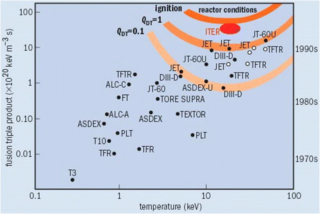The formula
Because OBV is a cumulative result, the value of OBV depends upon the starting point of the calculation.
On-balance volume (OBV) is a technical analysis indicator intended to relate price and volume in the stock market. [1] OBV is based on a cumulative total volume. [2]
Because OBV is a cumulative result, the value of OBV depends upon the starting point of the calculation.
Total volume for each day is assigned a positive or negative value depending on prices being higher or lower that day. A higher close results in the volume for that day to get a positive value, while a lower close results in negative value. [3] So, when prices are going up, OBV should be going up too, and when prices make a new rally high, then OBV should too. If OBV fails to go past its previous rally high, then this is a negative divergence, suggesting a weak move. [4]
The technique, originally called "continuous volume" by Woods and Vignola, was later named "on-balance volume" by Joseph Granville who popularized the technique in his 1963 book Granville's New Key to Stock Market Profits. [2] The index can be applied to stocks individually based upon their daily up or down close, or to the market as a whole, using breadth of market data, i.e. the advance/decline ratio. [2]
OBV is generally used to confirm price moves. [5] The idea is that volume is higher on days where the price move is in the dominant direction, for example in a strong uptrend there is more volume on up days than down days. [6]
Other price × volume indicators:

Relative density, also called specific gravity, is a dimensionless quantity defined as the ratio of the density of a substance to the density of a given reference material. Specific gravity for liquids is nearly always measured with respect to water at its densest ; for gases, the reference is air at room temperature. The term "relative density" is often preferred in scientific usage, whereas the term "specific gravity" is deprecated.
A market trend is a perceived tendency of the financial markets to move in a particular direction over time. Analysts classify these trends as secular for long time-frames, primary for medium time-frames, and secondary for short time-frames. Traders attempt to identify market trends using technical analysis, a framework which characterizes market trends as predictable price tendencies within the market when price reaches support and resistance levels, varying over time.
In computer science, the Floyd–Warshall algorithm is an algorithm for finding shortest paths in a directed weighted graph with positive or negative edge weights. A single execution of the algorithm will find the lengths of shortest paths between all pairs of vertices. Although it does not return details of the paths themselves, it is possible to reconstruct the paths with simple modifications to the algorithm. Versions of the algorithm can also be used for finding the transitive closure of a relation , or widest paths between all pairs of vertices in a weighted graph.
The relative strength index (RSI) is a technical indicator used in the analysis of financial markets. It is intended to chart the current and historical strength or weakness of a stock or market based on the closing prices of a recent trading period. The indicator should not be confused with relative strength.

The Lawson criterion is a figure of merit used in nuclear fusion research. It compares the rate of energy being generated by fusion reactions within the fusion fuel to the rate of energy losses to the environment. When the rate of production is higher than the rate of loss, the system will produce net energy. If enough of that energy is captured by the fuel, the system will become self-sustaining and is said to be ignited.
The money flow index (MFI) is an oscillator that ranges from 0 to 100. It is used to show the money flow over several days.
The accumulation/distribution line or accumulation/distribution index in the stock market, is a technical analysis indicator intended to relate price and volume, which supposedly acts as a leading indicator of price movements. It provides a measure of the commitment of bulls and bears to the market and is used to detect divergences between volume and price action - signs that a trend is weakening.
Average true range (ATR) is a technical analysis volatility indicator originally developed by J. Welles Wilder, Jr. for commodities. The indicator does not provide an indication of price trend, simply the degree of price volatility. The average true range is an N-period smoothed moving average (SMMA) of the true range values. Wilder recommended a 14-period smoothing.
In finance, return is a profit on an investment. It comprises any change in value of the investment, and/or cash flows which the investor receives from that investment over a specified time period, such as interest payments, coupons, cash dividends and stock dividends. It may be measured either in absolute terms or as a percentage of the amount invested. The latter is also called the holding period return.
The Negative Volume Index and Positive Volume Index indicators are indicators to identify primary market trends and reversals.

In statistical analysis of binary classification and information retrieval systems, the F-score or F-measure is a measure of predictive performance. It is calculated from the precision and recall of the test, where the precision is the number of true positive results divided by the number of all samples predicted to be positive, including those not identified correctly, and the recall is the number of true positive results divided by the number of all samples that should have been identified as positive. Precision is also known as positive predictive value, and recall is also known as sensitivity in diagnostic binary classification.

Joseph Ensign Granville, often called Joe Granville, was a financial writer and investment seminar speaker. He is most famous for inventing and developing the concept of "On-balance volume (OBV)". Granville argued that when volume increases sharply without a significant change in a stock's price, the price will eventually increase rapidly, and vice versa. On balance volume is thus one tool of technical analysis that attempts to predict future prices of stocks, commodities, and other financial assets traded on financial markets for which historical price and volume information is available.
Volume–price trend (VPT) is a technical analysis indicator intended to relate price and volume in the stock market. VPT is based on a running cumulative volume that adds or subtracts a multiple of the percentage change in share price trend and current volume, depending upon the investment's upward or downward movements.
The ulcer index is a stock market risk measure or technical analysis indicator devised by Peter Martin in 1987, and published by him and Byron McCann in their 1989 book The Investors Guide to Fidelity Funds. It is a measure of downwards volatility, the amount of drawdown or retracement over a period.
In technical analysis of securities trading, the stochastic oscillator is a momentum indicator that uses support and resistance levels. George Lane developed this indicator in the late 1950s. The term stochastic refers to the point of a current price in relation to its price range over a period of time. This method attempts to predict price turning points by comparing the closing price of a security to its price range.
Equilibrium constants are determined in order to quantify chemical equilibria. When an equilibrium constant K is expressed as a concentration quotient,
The TRIN, or Arms index, developed by Richard Arms in the 1970s, is a short-term technical analysis stock market trading indicator based on the Advance-Decline Data. The name is short for TRading INdex. The index is calculated as follows:
The advance–decline line is a stock market technical indicator used by investors to measure the number of individual stocks participating in a market rise or fall. As price changes of large stocks can have a disproportionate effect on capitalization weighted stock market indices such as the S&P 500, the NYSE Composite Index, and the NASDAQ Composite index, it can be useful to know how broadly this movement extends into the larger universe of smaller stocks. Since market indexes represent a group of stocks, they do not present the whole picture of the trading day and the performance of the market during this day. Though the market indices give an idea about what has happened during the trading day, advance/decline numbers give an idea about the individual performance of particular stocks.
In financial technical analysis, the know sure thing (KST) oscillator is a complex, smoothed price velocity indicator developed by Martin J. Pring.

Chaikin Analytics is a platform for stock trading ideas. It was founded in 2011 by Marc Chaikin. The centerpiece of Chaikin Analytics is the Chaikin Power Gauge stock rating. In 2016, it was named one of "Two Top Websites for Quantitative Analysis" by Barron's (newspaper).